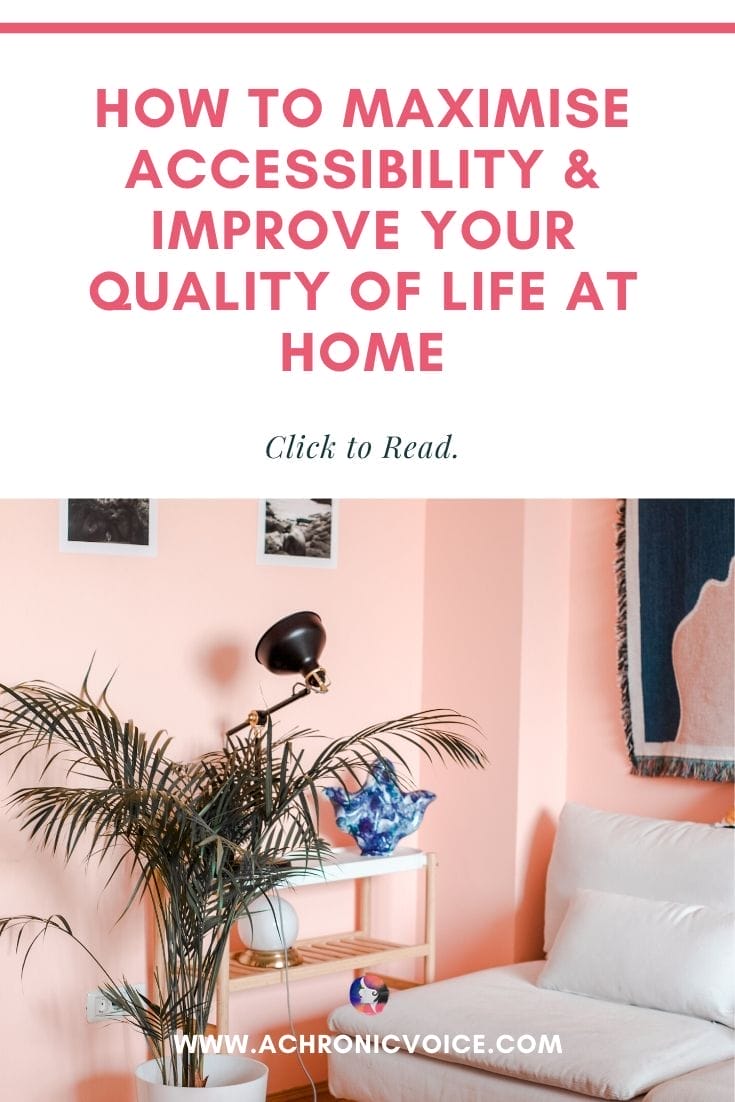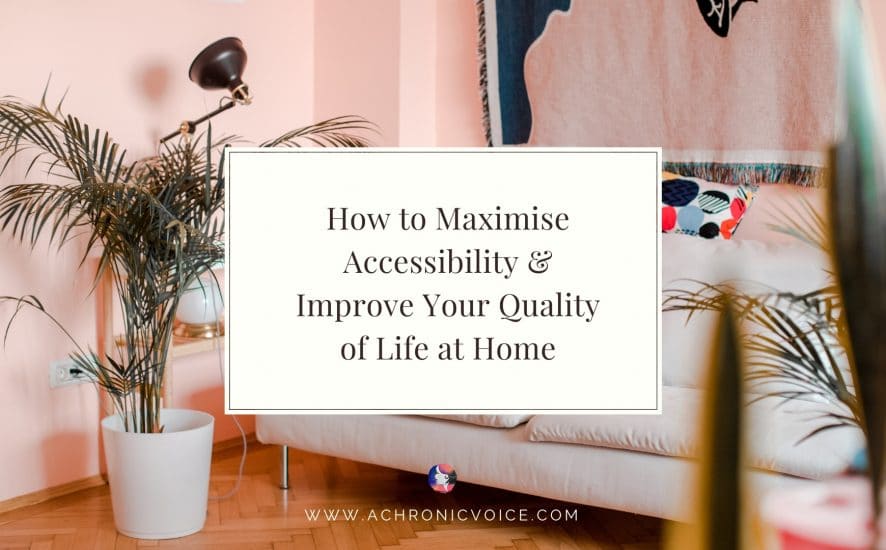Table of Contents
The Need for Accessibility When You Live with Chronic Pain or Disability
Adaptations and modifications of spaces are often required when you live with chronic pain or a disability. Many of us spend a lot of time at home, so it only makes sense that we transform it to suit our needs for a better quality of life.
There are a few rooms in our homes where high frequency of activity occurs. These are typically the bedroom, bathroom, kitchen, living room and entryway. The first question to ask if your home is accessible or not is, ‘Do you have trouble navigating within and across it?’. Barriers may include flooring material, slip hazards, and elevated surfaces.
Here are some ways to maximise accessibility, and make your home a safe and happy place to live in.
Bathroom
Let’s start with the bathroom, because this is a big one where 80% of falls occur for elderly adults. Common fall hazards include slippery surfaces and the lack of a seat to rest. Those with disabilities, chronic pain and the elderly may have trouble standing for long periods of time, become exhausted from the effort of showering, or become dizzy with the quick changes in temperature.
Some modifications you can make to improve accessibility in the bathroom include:
- Anti-Slip Mats. Place a rubber or anti-slip mat on surfaces that get wet all the time.
- Improve the lighting. Fog from heated showers may dim the bathroom, making it harder to see. This can be especially dangerous for those with vision problems.
- Install a shower chair. This reduces the amount of effort and concentration needed to shower, thus preventing unnecessary falls.
- Upgrade your shower doors. Doors with handles that require pushing, pulling or pressing can be frustrating, when your hands are already weak, and now wet as well. Handles can also provide a false sense of security, as one may grab onto them for support. Glass material can dangerous should they break, especially during a fall. You might want to install a shower door that opens and closes with a slight nudge.
- Upgrade your taps. Faucets that require twisting or turning can be pain-inducing, and sometimes even impossible to turn on and off. In fact, this contributes to more swelling in my hands, which can take days to recover from. A single tap that controls both hot and cold water temperature plus the amount of water with a slight lifting action is best.
- Install grab bars or rails. These are major tools that help a person sit and stand. I often ask for help from real human beings when switching from a lying or seated position to standing. So having grab bars in the shower for stability and support is a huge everyday aid.
Bedroom
Next there is the bedroom, where many of us spend most of our time in, either resting, sleeping or recovering. Here are some big and small things you can do to improve accessibility, and hopefully getter a better night’s rest!
- Mattress & Pillows. Your mattress and pillow directly affects your quality of sleep and physical health. If they are not comfortable or supportive enough, you might actually be perpetuating your pain. Rest and sleep are vital for healing, and a good mattress and pillows can play a huge role in that. They would in fact, be my first priority for a bedroom upgrade.
- Bedding Material. Many people with chronic illnesses suffer from allodynia or skin sensitivities. Synthetic material can be irritating to the skin. 100% organic cotton bedsheets are a good choice, but it can vary for each person. Other options are silk, bamboo, or a mix.
- Bed Height. The height of the bed and width of the mattress can also play a role. For example, I find it painful to bend down to sleep and rise from a short bed. Yet have difficulty climbing into one that’s too high as well. If the width of the mattress is smaller than that of the bed frame, this can create an addition barrier for getting into bed as well.
- Bedside Table. This is a must have for a person with chronic illness! Many of us have a drawerful of emergency medications and comfort tools beside our bed for quick and easy access. Having a lamp to light the room up for immediate visibility is also useful. This is also where many of us place our mobile phones, in case we need to make a call for help. If there are knobs attached to drawers, do ensure that they are not too small, and pull open with ease.
- Wardrobe. An organised wardrobe is not only pleasing to the eye, but makes everyday wear more accessible. Spread your clothing out a little for easy viewing. I use these foldable boxes from Ikea that have dozens of compartments, for separating underwear and small items. This makes it much easier to search for and retrieve an item.
Kitchen
The kitchen is another area where we spend a lot of time in, preparing meals, washing up, or making a cup of tea or coffee. The final meal may be simple, yet the energy taken to create it can quickly add up, with all the kitchen tools ‘hidden’ in drawers and cabinets everywhere! Here are a few ways you can modify your kitchen to improve accessibility:
- Place Items at Body Height. Take note of where a disabled or chronically ill person is able to reach up until. Do not place commonly used items in high shelf units, as that can make it impossible for them to access and use.
- Handles, knobs and taps. Whether they twist, pull or push, ensure that they are nice and easy to grab onto, and easy to turn on and off. It can be a struggle to turn a tap off when your fingers are soapy and arthritic. And it can be a hazard if the stove top cannot be turned off.
- Labels. Labelling containers and drawers can be a good idea, if a person suffers from memory problems or brain fog.
- Accessories & Kitchen Tools. There are kitchen tools out there that can help a person with chronic pain or disability to prepare, cook and clean with a little more ease. Inventions such as the rocking knife and grabber can make a big difference!
You can also transfer anything from bottles or packets that may be hard to open, into reusable airtight containers that are easy to access. Don’t forget to label them with the name and expiry date if you choose to do so!
Living Room
The living room is another major space in our houses. Many of us spend time on the sofa reading or watching TV, or entertaining guests. Living room spaces tend to be large with no support in any direction, so it is important to improve it where we can. For one, the flooring should be anti-slip. Support rails or mobility aids could also be placed where a person most likely needs them.
A good sofa that allows one to lie back or stretch out can make a difference. Good cushions and throws are easy ways to help make a person more comfortable as well. The coffee table should be at a comfortable height, and items placed on it should be within arm’s reach from the sofa.
A basket could be kept nearby to make things more accessible for a person. For example, they could keep their hobby equipment and other comfort tools in there. Baskets are also a great way to conserve energy around the house in general. You could keep separate ones in your kitchen and bathroom with room specific cleaning products. You could also keep one by the staircase, to carry up and down without the need to make two trips.
Smart Homes & Digital Tools
Smart homes are also on the rise, and digital tools should not be overlooked. Many devices can also be connected and controlled via your mobile phone. This reduces the need for repetitive actions such as switching the lights on and off. It can also help to save much effort such as getting out of bed, and walking from the bedroom upstairs to answer the door downstairs.
Home Lifts
A fantastic option for multi-storied houses is to install a domestic lift. This dramatically increases accessibility to every floor of your home. This helps a disabled or chronically ill person to be more independent, and move around their own homes with more confidence. It can also create more connections, as they are able to join a family member in another room with greater ease.
There are a few different types of lifts that could suit your specific needs. Some are wheelchair suitable, and others are small enough to even fit into your wardrobe! They could be for in or outdoor usage, and span a range of budgets and styles. A good lift is made of quality material, is quiet, and energy efficient as well. Don’t hesitate to ask the lift company as many questions as you like, so that they can give you the best recommendation. Installation is usually hassle-free, and some lifts can even be ready within 2 – 3 days.
I hope that these suggestions and tips have been of help to you. Do you live with a chronic illness or disability, or are a caregiver to one? What are your biggest accessibility barriers at home, and how have you overcame them to improve your quality of life? I’d love to hear your thoughts in the comments below, and am sure that they will be beneficial to another reader, too. Thank you!
Note: This list is just a rough guide, and nothing in this review should be taken as medical advice. Always be sure to check with your doctor before you start on any new treatment or protocol. Whilst this post is sponsored by Cibes UK, all opinions expressed within it are my own.
If you liked this article, sign up for our mailing list here so you don’t miss out on our latest posts! You will also receive an e-book full of uplifting messages, quotes and illustrations, as a token of appreciation!




Sheryl,
This is great! You’ve been really thoughtful in building this list, with suggestions that can have a wide range of investment costs, so that folks at any stage or state can pick up something useful to try! Making your living space safer and more comfortable is huge and a great way to improve your state of mind and sense of well-being.
Keep up the great work!
Thanks Alison! Yes I wanted to cover a wide range of budgets – it isn’t always expensive is best, although yes, some fancy tools can make a huge difference in one’s quality of life! But little things like baskets and knobs can matter so much, too!
This is such a brilliant list. When I renovated my home 6 years ago, I made sure we put hand-rails in the bathrooms thinking that if my old uncles and aunts came to stay, they should have these elements in the shower. 5 years ago, my mum had a stroke and my body went through a major health crash and we’ve used those railings the most, plus a bath stool. Both things have been absolutely precious to us.
You really have foresight and practicality, Shruti! Yes these little things may look humble, but help so much!
Great minds! I’m just putting a post together on items to help with accessibility. It really is good that there are getting to be more options now. I hope people are able to access an occupational therapist for help and suggestions.
That’s great that you’re putting together a post too, Claire! I too am glad that there are more options now than ever before 🙂
Sheryl, this is a fantastic post. Your tips to help make life easier are simple but very clever. I already do some of the things you’ve mentioned, but right now, I am going to get a basket (I’m sure I have one) to put all my ‘clutter’ into. I always have so much stuff lying around me. It will be much tidier looking and easier to find things if it’s together in a basket.
Sorry Elizabeth I just saw this comment! Yes simple sometimes does the trick, I think! 😉
These are fantastic suggestions! I especially love the tip about placing things at body height. The cabinets in my kitchen are impossible for me to reach, so instead of pulling muscles or breaking dinnerware, I bought a bookcase to display and store my plates, bowls, and glasses. I use the cabinets for storing things I rarely use.
Thanks Cynthia! And that’s a good idea/home hack you have there. A bookshelf sounds more accessible than some kitchen cabinets!